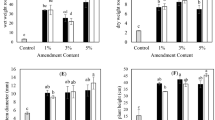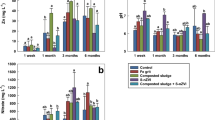Abstract
SOME 40% of the sludge produced at inland sewage works in England and Wales is applied to agricultural land1. In addition to the plant nutrients and organic matter they provide, such sludges also contain various quantities of heavy metals2. In some cases, repeated and very heavy dressings of sludge have led to accumulations of harmful elements that are toxic to plants3. There has been concern about their possible accumulation in agricultural soils receiving sludge4 since, as Tyler5 suggested, microbial activity in soils is susceptible to enhanced levels of heavy metals. The state of soils receiving sludge is monitored by regular analyses6, and the Advisory Services of the Ministry of Agriculture (ADAS) have recommended a combined upper limit7 to the total load (pre-existing and applied) of Zn, Cu and Ni, above which crop plants may be affected. We have investigated whether the approved quantities of sludge have adverse effects on the microorganisms responsible, in aerobic conditions, for mineralising the organic carbon in the soil, and have shown that three contrasting sludges from the same works, when mixed with soil in amounts up to five times the recommended limit, had no adverse effect on carbon mineralisation.
This is a preview of subscription content, access via your institution
Access options
Subscribe to this journal
Receive 51 print issues and online access
$199.00 per year
only $3.90 per issue
Buy this article
- Purchase on Springer Link
- Instant access to full article PDF
Prices may be subject to local taxes which are calculated during checkout
Similar content being viewed by others
References
Report of the Working Party on Sewage Disposal. Ministry of Housing and Local Government (HMSO, London, 1970).
Berrow, M. L., and Webber, J., J. Sci. Fd Agric., 23, 93–100 (1972).
Patterson, J. B. E., MAFF Tech. Bull., 21, 193–207 (1971).
Bryce-Smith, D. J., J. R. Soc. Arts, 120–154 (1973).
Tyler, G., Nature, 255, 701–702 (1975).
The “Hertfordshire” Practice (Thames Water Authority (Chiltern Division), Rickmansworth, Herts, 1972).
Chumbley, C. G., ADAS Advisory Paper, No. 10 (MAFF, HMSO, London, 1971).
Cornfield, A. H., Pl. Soil, 14, 90–93 (1961).
Author information
Authors and Affiliations
Rights and permissions
About this article
Cite this article
CORNFIELD, A., BECKETT, P. & DAVIS, R. Effect of sewage sludge on mineralisation of organic carbon in soil. Nature 260, 518–520 (1976). https://doi.org/10.1038/260518b0
Received:
Accepted:
Issue Date:
DOI: https://doi.org/10.1038/260518b0
Comments
By submitting a comment you agree to abide by our Terms and Community Guidelines. If you find something abusive or that does not comply with our terms or guidelines please flag it as inappropriate.



